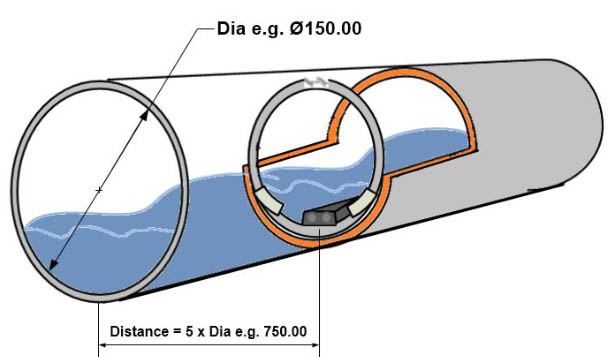A typical installation is in a pipe or culvert with diameters between 150mm and 2000 mm. The Ultraflow QSD 6537 should be located near the downstream end of a straight and clean culvert, where non-turbulent flow conditions are maximised. The mounting should ensure the unit sits right on the bottom to avoid debris catching beneath it.
It is recommended that in open pipe situations that the instrument is situated 5 times the diameter from the opening or discharge. This will allow instrument to measure the best possible laminar flow. Keep the instrument away from pipe joints. Corrugated culverts are not suitable for Ultraflow QSD 6537 instruments.

In culverts the sensor can be mounted on a stainless steel band that is slipped inside the pipe and expanded to lock it in position. In open channels special mounting brackets may be required. When installing the sensor, the mounting bracket is usually used to fix the sensor in an appropriate position.
Remarks
The sensor should be installed in a position that avoids the covering of sediment and alluvium and fluids. Ensure that the cable is long enough to be connected the calculator. When installing in riverbed, underwater or other channels, the installation bracket can be directly welded to the bottom of the channel, or can be fixed with cement or other base as needed. The Ultraflow QSD 6537 Sensor is used to measure water velocity, depth, and conductivity of water flowing in rivers, streams, open channels and pipes.Ultrasonic Doppler Principle in Quadrature Sampling Mode is utilised to measure water velocity. The 6537 Instrument transmits ultrasonic energy through its epoxy casing into the water.
Suspended sediment particles, or small gas bubbles in the water reflect some of the transmitted ultrasonic energy back to the 6537 Instrument’s ultrasonic receiver instrument that processes this received signal and calculates the water velocity.
Post time: Aug-24-2021

